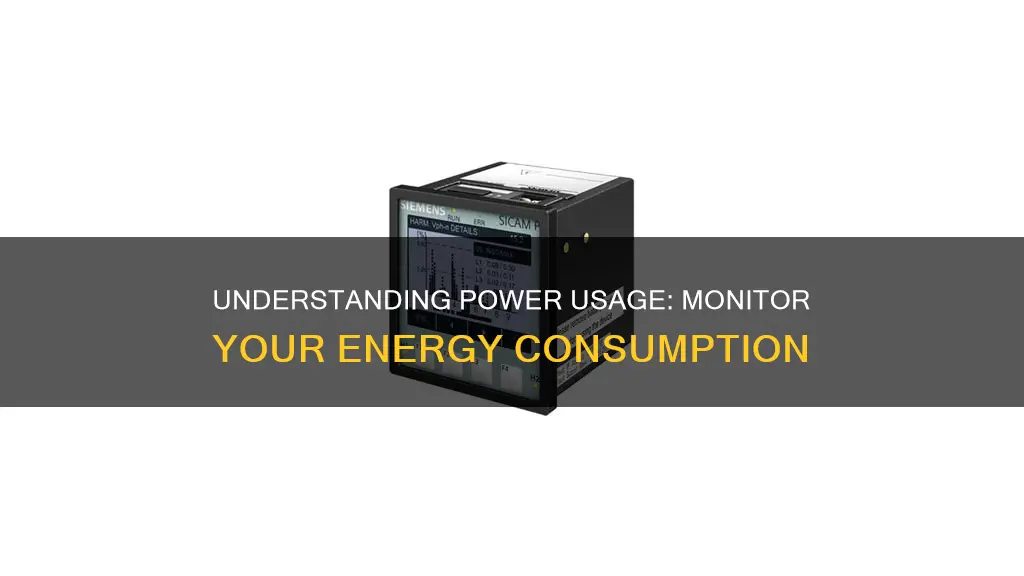
A power usage monitor is a device that helps you measure the energy consumption of your home or individual appliances. It can be a simple plug-in socket power meter or a more complex whole-house electricity usage monitor. These devices help you identify energy-wasting appliances and vampire energy, which are devices that use power even when they are turned off or on standby mode. Power usage monitors can also help you save money on your electricity bill and reduce your carbon footprint.
| Characteristics | Values |
|---|---|
| Purpose | To monitor and control energy usage and costs |
| Functionality | Measure energy usage, estimate costs, identify devices, provide insights and tips, control smart devices |
| Compatibility | Smartphones, smart home devices, solar power systems, specific circuits, appliances |
| Installation | Plug-in, whole-house, Wi-Fi/cloud-based, DIY/electrician |
| Display | LED/LCD, backlit, large, clear, easy-to-read |
| Data | Real-time, historical, cumulative, estimated, compared with similar homes |
| Control | Smartphones, smart home hubs, voice assistants |
| Security | Isolated Wi-Fi, cloud-based, password protection |
What You'll Learn

Power usage monitors can help you save money and reduce your carbon footprint
Power usage monitors are devices that help you measure how much electricity your appliances are consuming. They can be in the form of smart plugs, standalone electricity monitors, or whole-home energy monitors. These devices can provide valuable insights into your energy consumption habits, helping you identify areas where you can save money and reduce your carbon footprint.
Smart plugs, such as the BN-Link – BNC-60, are an affordable and easy-to-use option for monitoring power usage. They connect to your Wi-Fi and allow you to track the energy usage of individual appliances. With smart plugs, you can also set up automated routines and control your devices remotely.
Standalone electricity monitors, like the Fayleeko, are another option. These devices have a large, backlit screen that displays real-time power consumption data, including current draw, voltage, frequency, power factor, and total cost of power used. They are simple to use and provide accurate readings for most appliances.
For a more comprehensive solution, whole-home energy monitors, such as the Emporia – Vue, offer circuit-level monitoring. These systems require installation by a qualified person and involve placing sensors on individual breaker wires in your electrical panel. They provide detailed insights into the energy usage of different areas of your home, allowing you to track specific rooms or appliances. Some whole-home monitors, like the Sense Energy Monitor, use device-detection algorithms to identify the unique electrical signatures of your appliances.
By using power usage monitors, you can identify energy vampires—devices that consume power even when turned off or on standby. These devices can contribute significantly to your electricity bill and increase your carbon footprint. By becoming more aware of your energy usage, you can make informed decisions to reduce consumption, save money, and lower your environmental impact.
Additionally, some power usage monitors can help you identify opportunities to upgrade to more energy-efficient appliances or lighting systems, such as LED bulbs, further reducing your energy costs and carbon footprint. With the data provided by these monitors, you can make brighter choices that positively impact both your wallet and the environment.
Monitoring Electricity Usage: A Guide to Tracking Your Power Consumption
You may want to see also

They can be used to track energy usage of individual devices
Power usage monitors can be used to track the energy usage of individual devices. They are small devices that are installed in the circuit breaker panel of a house or apartment. They can help identify which devices are drawing power and how much they're drawing. This is known as load disaggregation.
There are a few different types of power usage monitors available:
- Direct-read power monitors: These are watt meters incorporated into electrical sockets. You plug them into a standard supply outlet, and then plug in the device you want to measure. They will tell you how much power is being used, and usually include a data logger and price calculator to estimate costs.
- Smart plugs with power monitoring: These are electrical adapters with computer-networked switching controls. In addition to giving you statistics about how much power your appliances use, these smart plugs can also be used to trigger smart home programs with certain types of power draw.
- Whole-house electricity usage monitors: This type of monitor sits inside your home electrical breaker panel and measures current draw, either at the main supply cables or at individual circuit breakers.
Some examples of power usage monitors include:
- P3 Kill A Watt EZ: One of the simplest, least expensive, and best-known plug-load power monitors. It can auto-calculate how many kilowatt-hours a device uses in a day, week, month, or year.
- BN-Link – BNC-60: A Wi-Fi monitoring smart plug that is affordable and easy to use. It reads voltage and up to 15 amps of current directly, and the app allows you to track the usage history of whatever is plugged into it.
- Fayleeko: A stand-alone plug-in electricity monitor that gives you all the expected power measurements and makes them easy to read, thanks to its giant backlit screen.
- Emporia – Vue: A whole-home monitoring system that gives you more detail than your power company provides. It lets you track circuits independently, so you can track your kitchen, laundry, heating, and entertainment appliances together without jumping between apps or manually checking stand-alone meters.
- Sense Energy Monitor: One of the earliest whole-home energy monitors available, it uses machine learning to identify individual appliances and their electricity usage.
Monitoring Sprint Hot Spot Usage: A Comprehensive Guide
You may want to see also

They can be used to track energy usage of the whole house
Power usage monitors can be used to track the energy usage of the whole house. These devices are known as whole-house power monitors or whole-home electricity monitoring tools. They are equipped with sensors that can be connected to the electrical panel or electricity meter of a house, allowing them to track power consumption across all appliances connected to a particular circuit.
Whole-home energy monitors provide a comprehensive view of energy usage, enabling homeowners to identify areas where they can optimise their energy usage and reduce their carbon footprint. They can also help in detecting "vampire loads", which are devices that continue to draw power even when on standby or sleep mode. Vampire loads can contribute significantly to electricity bills, so being able to identify and manage them can lead to notable cost savings.
Some advanced whole-home energy monitors, such as the Sense Energy Monitor, can even pinpoint the electronic signature of each device, providing detailed insights into the energy usage patterns of individual appliances. This level of granularity can help users make informed decisions about their energy usage and take targeted measures to optimise their energy consumption.
Whole-house power monitors are generally installed by electricians, but some models are designed to be easily set up by anyone. They are typically more expensive than plug load monitors, with prices ranging from $299 to $349 for popular brands like TED Pro, Sense Energy, and Eyedro. However, cheaper alternatives like the Eyedro home version are also available for as low as $99.
Monitoring Internet Usage: Free LAN Solutions
You may want to see also

They can be used to identify sources of energy waste
Power usage monitors are devices that help you measure how much electricity your appliances are consuming. They can be used to identify sources of energy waste, also known as "vampire energy". Vampire energy refers to the electricity that is being used by devices when they are in standby mode or when they are turned off but still plugged in.
Power usage monitors come in various forms, such as smart plugs, direct-read power monitors, and whole-house electricity usage monitors. Smart plugs like the BN-Link – BNC-60 allow you to monitor power usage and control appliances remotely. Direct-read power monitors, like the P3 Kill A Watt EZ, are simple plug load monitors that display the power consumption of the device plugged into them. Whole-house electricity usage monitors, like the Emporia – Vue, require installation by a qualified person and provide circuit-level data on power usage.
By using these power usage monitors, you can identify which devices are consuming electricity even when they are not in use. For example, devices with LED lights or clocks, such as microwaves, coffee makers, or smart speakers, can contribute to vampire energy. Additionally, devices that perform updates or connect to the internet while turned off can also draw power. By identifying these sources of energy waste, you can take steps to reduce your energy consumption and lower your electricity bills.
Monitoring Tableau Report Usage: A Comprehensive Guide
You may want to see also

They can be used to track energy usage of a PC
Power usage monitors are devices that help you track the energy consumption of various appliances in your home. They can be used to monitor the energy usage of a PC, which can be helpful if you want to reduce your electricity bills or prolong the lifespan of your computer.
To measure your PC's power usage, you can use a wattage meter, such as the SURAILEC Watt Meter, which costs around $11 on Amazon. Plug the watt meter into the wall socket, and then plug your computer's main power pin into the watt meter. If you're using a desktop, you'll need to do the same for your monitor and add the two wattages to get the total system draw.
Another way to measure your PC's power consumption is by using software such as HWInfo or Open Hardware Monitor. These tools can provide an approximation of your PC's power draw by measuring the power consumption of its most energy-intensive components, such as the CPU and GPU. However, this method may not include the power draw of your monitor or laptop display.
Additionally, you can use online calculators, such as the OuterVision Power Supply Calculator or the Be Quiet! PSU Calculator, to get a rough estimate of your PC's power usage based on the components you have selected. These calculators are free to use and don't require any installation.
For whole-home monitoring, you can consider systems like the Emporia - Vue, which allows you to track energy usage for individual circuits in your home. This system requires installation by a qualified person, but it provides detailed information about your power usage.
By using these tools and methods, you can effectively track and manage the energy usage of your PC, helping you save energy, reduce costs, and prolong the lifespan of your computer.
Monitoring Data Usage: DD-WRT for Device Control
You may want to see also
Frequently asked questions
A power usage monitor is a device that helps you measure how much electricity your home, appliances, or PC is consuming. This can help you identify any "vampire energy" leaks and save on your electricity bill.
Power usage monitors come in various forms, including smart plugs, direct-read power monitors, and whole-house electricity usage monitors. Smart plugs with power monitoring features can track power usage and trigger smart home programs based on power draw. Direct-read power monitors are typically incorporated into electrical sockets, allowing you to plug in an appliance and track its power usage. Whole-house electricity usage monitors are installed in your home's electrical breaker panel and measure current draw at the main supply cables or individual circuit breakers.
When choosing a power usage monitor, consider factors such as smart home system compatibility, solar system compatibility, size, screen readability, and power factor measurement. If you want to monitor individual appliances, smart plugs or direct-read power monitors are suitable. For whole-house monitoring, consider systems like Emporia – Vue or Sense Energy Monitor, which provide detailed insights into your home's energy usage.







